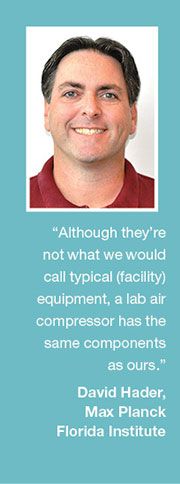Max Planck Florida Institute: FM Team Expands Role, Adds Value
Part 4 of a 6-part article profiling the 2016 FMXcellence honorees.
The Max Planck Florida Institute opened in 2012 on the campus of Florida Atlantic University. Its LEED-NC Gold certified building spans 100,000 square feet, including about 58,000 square feet of laboratory space that houses roughly one hundred researchers. The Max Planck Society, based in Munich, Germany, conducts research in the natural, life, and social sciences, and the humanities.
Given the research conducted at the facility, ensuring the lab equipment remains in top working condition is critical. The five-person facilities team, which already was tracking, maintaining, operating, and repairing more than 800 assets, developed a program to handle these functions for about 150 pieces of lab equipment, relieving researchers of the responsibility.
“Although they’re not what we would call typical maintenance equipment, a lab air compressor has the same components as ours. The vacuum pumps are still the same,” says David Hader, facility manager.
 Several factors contributed to Hader’s belief that his facility team could add value by adding the lab equipment to its responsibilities. Previously, it wasn’t unusual for an outside service person to show up several times in one week, each appointment for different researchers. “We could benefit from economies of scale by bringing everything under one group’s direction,” Hader says.
Several factors contributed to Hader’s belief that his facility team could add value by adding the lab equipment to its responsibilities. Previously, it wasn’t unusual for an outside service person to show up several times in one week, each appointment for different researchers. “We could benefit from economies of scale by bringing everything under one group’s direction,” Hader says.
Hader also recognized that his team could add value through its expertise in equipment upkeep. For instance, when the scientists handled that responsibility, they often waited before reporting a problem, uncertain whether any servicing was needed. In contrast, a solid preventive maintenance program would begin investigating when a piece of equipment appeared to operate outside established parameters, in order to minimize damage and downtime. “When no action is taken, temporary downtime is the best-case scenario,” Hader says. “The potential loss of productivity, priceless samples, and extensive hours of research represent the worst case scenarios.”
By late 2014, Hader’s department had assumed responsibility for upkeep of about 150 pieces of lab equipment. While he presented a compelling case for the change, he was careful not to force it on any of the scientists. “We recognize that, for researchers, their equipment is their lifeblood, and they’re sensitive about how it’s handled,” Hader says. Several groups continue to handle their own upkeep.
Training the facilities staff also was critical. “A big part of it was understanding how the equipment was being used,” Hader says. For instance, scientific equipment can’t simply be shut down in order to undertake preventive maintenance.
The preventive maintenance cut the energy used by the equipment. Energy costs for a poorly maintained freezer, for instance, might run $1,200 annually, compared with $300 for a properly maintained one. The program also reduced unscheduled downtime, as well as the expense of outside service providers. And it frees the scientists to concentrate on their research.
Top photo caption and credit: At the Max Planck Florida Institute, the FM team took over the preventive maintenance for some of the scientific equipment, allowing the researchers to more fully focus on science, and gaining cost and energy efficiencies for the organization. Credit: ZGF Architects
Related Topics:









 Several factors contributed to Hader’s belief that his facility team could add value by adding the lab equipment to its responsibilities. Previously, it wasn’t unusual for an outside service person to show up several times in one week, each appointment for different researchers. “We could benefit from economies of scale by bringing everything under one group’s direction,” Hader says.
Several factors contributed to Hader’s belief that his facility team could add value by adding the lab equipment to its responsibilities. Previously, it wasn’t unusual for an outside service person to show up several times in one week, each appointment for different researchers. “We could benefit from economies of scale by bringing everything under one group’s direction,” Hader says.







